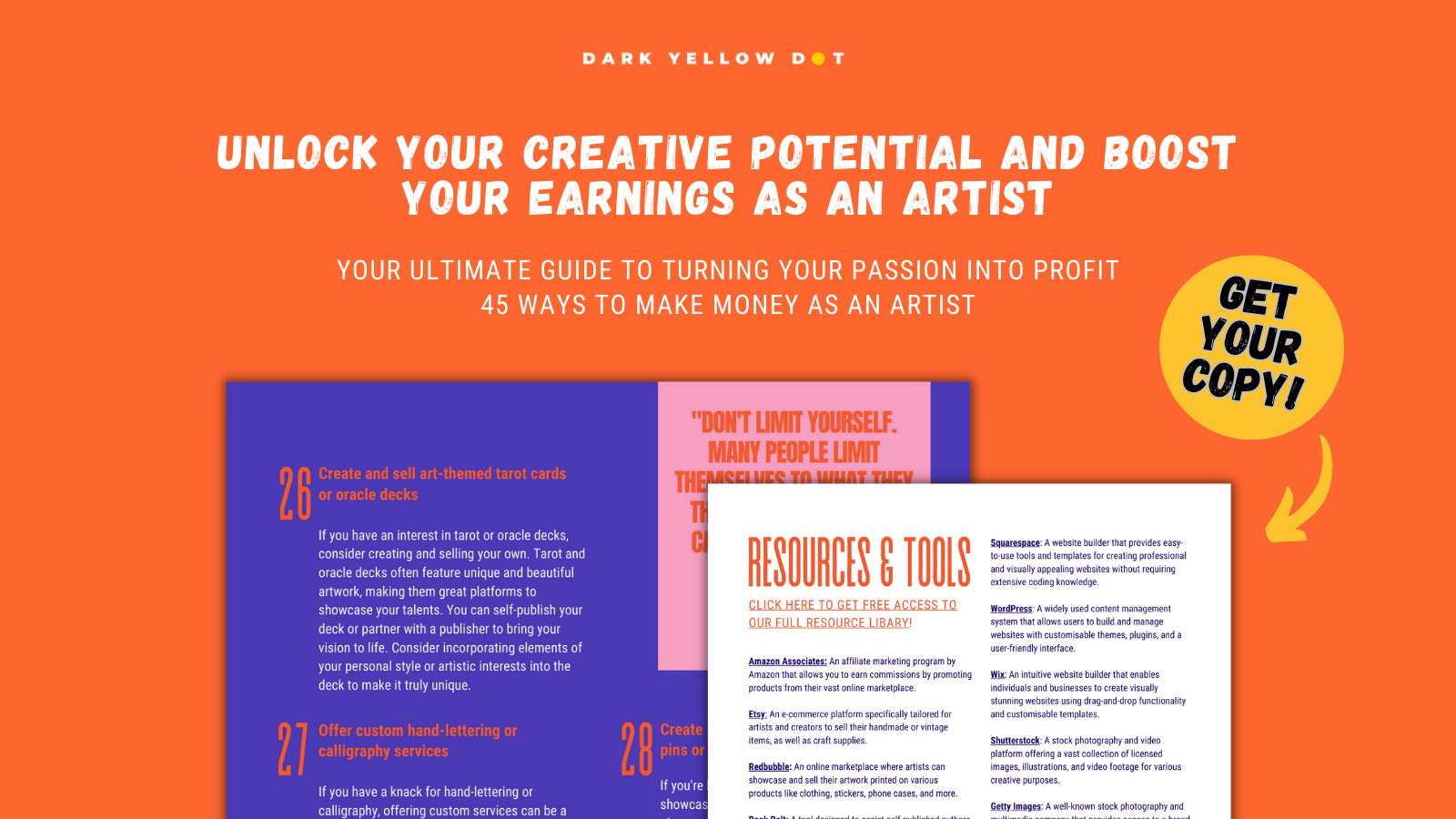

12 Tips for Selling Your Art Online (Beginners Guide)
Heads up: This post may contain affiliate links, Learn more.
How to sell art online and make money as a new artist
There is a preconceived notion that the only way to make a living as an artist is to hand your work over to a gallery owner in the hopes of making a profitable sale. But that’s just one of the many, many ways to make a living from your art. The rapid growth and advancement of technology have greatly increased the ease of doing business.
The advent of e-commerce has made it possible to buy and sell almost anything online, including artwork. Today buyers and sellers from all across the world meet in virtual marketplaces. You can very easily start selling your art online, promote it, and attract customers from all over the world.
It is possible to quit your day job and make art your full-time career. The “starving artist” is a mere myth and we’re here to show you how to keep that from becoming a reality.
Here are 12 simple tips for selling art online as a beginner:
1. Find Your Niche
Before you begin to sell your work online, its good idea to find your niche and your unique style that sets your artwork apart from the rest. This will convey your strengths to your potential clientele and reflect who you are as an artist.
It may be tempting to go broad with your art style choices but, learning from experience you’ll have a much higher chance of success if you narrow down your style, medium or theme to create or work within a niche.

2. Get to Know Your Art Business
If you’re just starting out, it’s a good idea to begin a self-study course for art business. Taking an online course has its own advantages as they’re easily accessible, more affordable, and you can go at your own pace. Our Resource Library has tons of online courses and business tools for artists.
By taking courses and reading books, you’ll be able to determine how to best manage your money, any legal items you may not have considered, what to do about taxes and self-employment, and so many other invaluable areas of an independent art business you’ll eventually need to learn, so start now and save yourself time by learning from others.
3. Find the right marketplace to sell your art
A good method for selling your art online is online marketplaces that are specialised in selling and buying art. ArtFinder is an incredible platform for artists selling original and unique pieces.
Art buyers from all over the world visit ArtFinder to purchase work from emerging artists. The site’s art sale success rate is relatively high even for first timers. Artists are making thousands of pounds using this platform. It may not be for everyone, but it’s worth a try.
The renowned Saatchi Gallery also has their own marketplace for artists selling art online. Many people join this platform for the reputation the gallery has, not to mention the quality of inbound traffic and potential sales it can attract to your art website.
Etsy is another very well known online marketplace for artisans, crafters, and creatives selling handmade products, prints and unique goods. It’s a very saturated marketplace, so it an be difficult for your listings to show up in search results, especially when you’re just starting with no previous audience or sales.
There are many things to consider when posting your artwork for sale on Etsy, good knowledge of search engine optimisation (SEO) and keyword research will get you started the right way. Illustrator Bonnie Lecat has a course on how to successfully sell on Etsy.
4. Don’t rely on one stream of income
An important thing to do when you’re selling your art online, is to utilise different online platforms or art marketplaces. At the start, it’s best to focus your efforts on one platform, correct and learn from your mistakes before moving on to listing your art on other platforms.
Perhaps your art doesn’t sell very well on a certain website, but it could do very well with another. Selling your art on different marketplaces is a great way to expand your income sources. Consider selling your artwork in a few different ways, with both high and lower price points.
You may want to sell original art pieces, art prints, stickers, calendars, cards, T-shirts, mugs you name it. Just make sure you don’t sacrifice the quality of your work when you decide on products to sell your art on.
If you’re skilled in working with a particular art medium, you might even consider teaching workshops, or launching your own online course. Platforms like Skillshare and Teachable are great places for creatives to teach what they know, in order to create an extra stream of income for themselves.
You can also try selling your art on online auctions, in crafts fairs, art markets and online galleries. Whatever you choose, make sure you do your research and only pick the ones that are trusted and reputable. If you’re not sure where to start with online auctions, you can try your hand at an Instagram auction like @seeyounexthursday
Ways to sell your art and diversify your income online and offline:
-
- Selling art prints and original pieces on online marketplaces or your own website
- Sell your art on products like stickers, stationary, t-shirts, mugs with print-on-demand
- Teach your artistic skills through workshops or launch a course
- Sell your art in online auctions
- Sell at local craft fairs and art markets
5. Create an e-commerce art shop on your own website
If you already have your own website or online art portfolio but don’t want the involvement of a third party marketplace, you can sell your work on your own website. Whether you sell your work in an online gallery or elsewhere, it’s still necessary to have your own website or online portfolio.
The design of your website should reflect your artistic style and act as a showcase for potential buyers and fans of your artwork. It should feature your best quality work and be a virtual representation of your brand.

Get started with easy drag & drop site-builders:
-
- Wix (Drag & Drop, best for beginners with no experience)
- SquareSpace (Best for beginners & designers)
- WordPress (Best for creators with website building experience)
6. Consider Print-on-Demand products
Print on demand websites are also becoming increasingly popular platforms for artists and designers to profit from their art. Once you’ve uploaded a high-quality image of your artwork, it can be printed on just about anything. The best part is, after you’ve submitted your work, the website takes care of the rest.


Get started:
-
- Society 6 – (best for illustrators, printmakers, photographers)
- Deviant Art – (best for character designers, illustrators)
- Zazzle – (best for illustrators and designers)
- RedBubble – (best for illustrators and designers)
- Printful – (best for illustrators, printmakers, painters)
7. Get Social Media Savvy
For independent artists, art marketing is an important part of selling your artwork especially online. The art world is saturated with fine artists trying to do the same thing. You’ll find that it’s a lot easier to sell your work to an existing audience.
If you use social media to connect and engage with the people who are interested in your artistic skill and already find your Instagram page inspiring, you’ll have a captive audience ready to sell to.


Instead, give your audience a sense of who you are as the person behind the art. Share behind the scenes, your art studio, or talk about the inspiration for your pieces. This will help them to build trust and confidence in you and your work.
8. Know your worth, and how to price your art accordingly
When it comes to pricing your art, it’s important to research the various ways to do this while still making sure you don’t underprice or overprice your artwork.
If you’re a beginner and have never sold your work before, rather than pulling random numbers out of the air, you may find it useful to use an art pricing formula to begin with and make adjustments as you grow.


All you do is put in the size, medium and style of your artwork and boom, you get a price. You will need to make some adjustments up or down, and prices are shown in US dollars so you’ll also need to convert the currency if you’re not in the US.
9. Make Professionalism a Priority
If you’re accepting payments online, you need a very secure eCommerce store for people to feel safe and confident about buying your work online. Make the payment process easy and secure. Also make sure you are compliant with the policies on returning goods and giving refunds.
Another thing to keep in mind is, don’t start selling until you’ve worked out how you are going handle packaging and shipping and make sure you’re very clear on where in the world you are willing to ship to. Paypal is a great way to begin accepting online payments as they integrate with almost every platform and website builder and it’s free and easy to set up and use.

10. Get to know the legal side of things
Selling art online means you should know, understand and observe the laws and legal items pertaining to selling, trading and buying artwork. Find helpful websites, courses, and books on our Resources Library. The other side of the equation is to understand the rights to your own intellectual property.
Would you know what to do if you discovered someone on the internet reselling your artwork as their own? A-N insurance is great website to get information from, the Business and IP Centre at the British library, and ArtLaw have hundreds of resources and free legal advice for artists.
11. Know Your Customer
It’s important to understand who your online consumers are and what they’re looking for in their search for online art. You need to know who it is you’re trying to attract and what exactly it is that they want. Pay attention when people compliment your work. Keep an eye on your social media too.
Which posts have the most comments, likes and shares? Do you receive feedback on the same art pieces time and time again? These are indicators that these are pieces of art that sells best to the people most likely to purchase it.

12. Describe your artwork with the love you put into it
Lastly, you’re likely here because trying to make more virtual sales, so it’s very important to communicate the value of your work to your customers online as you’re not there to talk with them in person as you might at art fairs or artist market.
Connecting with people virtually and describing the stories and inspiration behind your art, the process involved in making it, even where the materials were sourced would surely help people to better understand the quality of your artwork and value you as the artist behind it.
Share your passion for art with your audience and they’ll feel more inclined to support the work you do.
Need more advice?
It is possible to create the kind of art you want to make and earn good money doing it. The web allows you to sell directly to your fans and reach new audiences of potential buyers. You can cut out the middleman and become the exclusive dealer of your own work. There is enormous potential in online art sales and with careful and strategic use of the Internet, the possibilities are limitless.
Sites to help:
Courses to help:
If you have any more advice leave them in the comments below! Click the share buttons, send this post to a friend or join our Mail Squad for more posts like this one. Thanks for reading, and don’t forget to share your art with us by submitting your work or tag #darkyellowdot on Instagram
If you found these tips and resources helpful to begin selling your art online, share this post, that makes up happy.


13 Comments
-
-
-
Julie kargel
Fantastic information. Thank you. I feel more confident now.
-
Kevin Smith
Choosing the right platform, however, has become the tricky part because there’s only so much time in the day to make art, photograph it correctly, put it up for sale, and manage the business side of things.










Rhonda Sumner
I would just like to say Thank you for spending your time in helping myself and others by providing all the information that you did so that we can understand the steps to take to get started i had just opened my laptop and my grandson looked at me and said what are you looking up grandma and i replyed i think im going to check and see if it would be hard to write a book he ask what would you write about what kind of book well im not sure maybe a childrens book about that time we both just cracked up then he said im thinking you are going to need help lol some how while this was going on i ended up here he had said i would need help because he knows i dont work a conputer very well lol with all that being said i stayed right here lol Thank you again